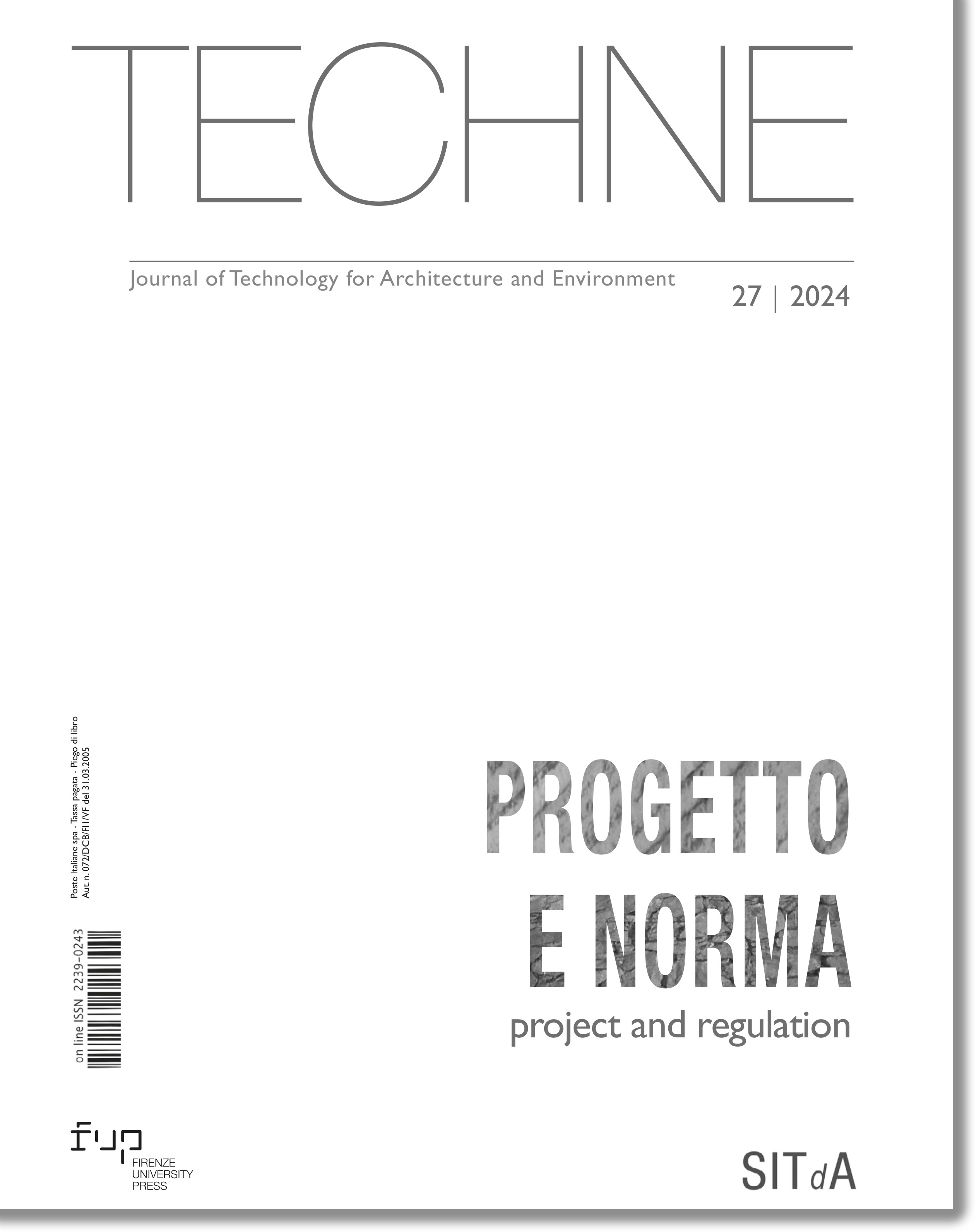Climate proofing of the urban environment between process and design: a holistic and participatory methodology
Published 2024-06-10
Keywords
- Climate change,
- Resilience,
- Climate Adaptation,
- Stakeholder Engagement,
- Citizen Empowerment
How to Cite
Copyright (c) 2024 Fabrizio Tucci, Serena Baiani, Gaia Turchetti, Paola Altamura

This work is licensed under a Creative Commons Attribution 4.0 International License.
Abstract
Defining procedural processes to support the involvement and empowerment of citizens, the main target of climate change, in order to integrate them into the holistic process of adaptation to extreme events is nowadays an extremely topical issue. Research is working towards the progressive standardisation of this process. The paper focuses on the outcomes of research on integrating the participatory approach into a methodology for climate proofing of the urban environment. The research results are include directions for increasing resilience through a cyclic step-by-step process for planning, prevention and management of the effects of disasters, centred on the involvement of different stakeholders, as well as the outcomes of the experimentation of such a process on three public housing (ERP) neighbourhoods in Rome.
Downloads
References
- CEN/CWA 17727 (2022), City Resilience Development - Guide to combine disaster risk management and climate change adaptation - Historic areas, CEN-CENELEC, Brussels.
- Charli-Joseph, L., Siqueiros-Garcia, J.M., Eakin, H., et al. (2018), “Promoting agency for social-ecological transformation: a transformation-lab in the Xochimilco social-ecological system”, Ecol. Soc., Vol. 23 (2), p.46. DOI: https://doi.org/10.5751/ES-10214-230246
- Dannevig, H., Groven, K., Hovelsrud, G., A et al. (2019), “Framework for agenda-setting ocean acidification through boundary work”, Envir. Science & Policy, Vol. 95, pp. 28-37. DOI: https://doi.org/10.1016/j.envsci.2019.02.001
- Dannevig, H., Hovelsrud, G., Hermansen, E., et al. (2020), “Culturally sensitive boundary work: A framework for linking knowledge to climate action”, Envir. Science & Policy, Vol.112, pp. 405-413. DOI: https://doi.org/10.1016/j.envsci.2020.07.002
- Del Nord, R. (1987), “Il ruolo della tecnologia e della normativa tecnica nel processo di progettazione e di edificazione”, in Gangemi, V. and Ranzo, P. (Eds.), Il governo del progetto, Luigi Parma, Bologna, pp. 18-26.
- European Commission (2021), Plasmare un’Europa resiliente ai cambiamenti climatici – La nuova strategia dell’UE di adattamento ai cambiamenti climatici, COM (2021) 82 final. Available at: https://eur-lex.europa.eu/legal-content/IT/TXT/PDF/?uri=CELEX:52021DC0082 (Accessed on 01/09/2023).
- European Commission (2021), Orientamenti tecnici per infrastrutture a prova di clima nel periodo 2021-2027, C 373/1. Available at: https://eur-lex.europa.eu/legal-content/IT/TXT/PDF/?uri=CELEX:52021XC0916(03)&from=HR (Accessed on 01/09/2023).
- European Commission (2023), Do it yourself (DIY) manual for mobilising and engaging stakeholders and citizens in climate change adaptation planning and implementation. Available at: https://climate-adapt.eea.europa.eu/en/mission/solutions/citizen-engagement-manual (Accessed on 01/09/2023).
- FSS Fondazione Sviluppo Sostenibile (2019), Relazione sullo stato della Green Economy. Focus sugli impatti dei cambiamenti climatici in Italia. Available at: https://www.reteclima.it/wp-content/uploads/Relazione_sullo_stato_della_green_economy_2019.pdf (Accessed on 01/09/2023).
- Green City Network (2019), Dichiarazione per l’adattamento climatico delle green city. Available at: https://www.greencitynetwork.it/wp-content/uploads/Dichiarazione-Adattamento-climatico-Green-City.pdf (Accessed on 01/09/2023).
- International Association for Public Participation (2018), IAP2 spectrum. Available at:
- https://cdn.ymaws.com/www.iap2.org/resource/resmgr/pillars/Spectrum_8.5x11_Print.pdf (Accessed on 01/09/2023).
- IPCC (2022), Climate Change 2022: Impacts, Adaptation and Vulnerability, Cambridge University Press, doi: 10.1017/9781009325844. DOI: https://doi.org/10.1017/9781009325844
- Legambiente (2022), Il clima è già cambiato gli impatti di siccità e caldo estremo sulle città, i territori e le persone. Available at https://www.legambiente.it/wp-content/uploads/2022/11/Rapporto-CittaClima-2022.pdf (Accessed on 01/09/2023).
- Lindner R., Lückerath D., et al. (2021), “The Standardization Process as a Chance for Conceptual Refinement of a Disaster Risk Management Framework: The ARCH Project”, Sustainability Vol.13, (21), p.12276. DOI: https://doi.org/10.3390/su132112276
- Nanz, P., Fritsche, M. (2014), La partecipazione dei cittadini: un manuale Metodi partecipativi: protagonisti, opportunità e limiti, Regione Emilia-Romagna, Bologna.
- OECD (2019), Resilience-based Strategies and Policies to Address Systemic Risks - SG/NAEC(2019)5. Available at: https://www.oecd.org/naec/averting-systemic-collapse/SG-NAEC(2019)5_Resilience_strategies.pdf (Accessed on 01/09/2023).
- Pereira, L., Olsson, P., Charli-Joseph, L., et al. (2021), “Transdisciplinary methods and T-Labs as transformative spaces for innovation in social-ecological systems”, Transdisciplinary J.of Engin. & Science, Vol. SP-1, pp. 13-16. DOI: https://doi.org/10.4324/9780429331930-6
- Regione Emilia-Romagna (2009), Partecipare e decidere. Insieme è meglio Una guida per amministratori e tecnici. Available at:
- http://partecipazione.formez.it/sites/all/files/Guida%20Partecipazione%20RER.pdf (Accessed on 01/09/2023).
- Rezaei, M. (2021), “Normative and Positive Theories”, in: Rezaei M. (Ed.), Reviewing Design Process Theories, Springer. DOI: https://doi.org/10.1007/978-3-030-61916-9
- Sharifi A., Chelleri L., Fox-Lent C., et al. (2017), “Conceptualizing Dimensions and Characteristics of Urban Resilience: Insights from a Co-Design Process”, Sustainability, vol. 9 (6). DOI: https://doi.org/10.3390/su9061032
- Spadolini, P., et al. (1989), Normativa tecnica e industrializzazione dell’edilizia, Luigi Parma, Bologna.
- Torricelli, M.C. (1990), Normazione Qualità Processo edilizio, Alinea, Firenze.
- Tucci, F. (2019) “Adattamento ai cambiamenti climatici di Architetture e Città ‘Green’ per migliorare la resilienza dell’Ambiente Costruito. Minacce, vulnerabilità, rischi. Assi strategici, indirizzi, azioni d’intervento”. Available at https://www.greencitynetwork.it/wp-content/uploads/Adattamento-ai-cambiamenti-climatici.pdf.
- Tucci, F., Baiani, S., D’Olimpio, D., Altamura, P. and Turchetti, G. (2020a), “Resilience, adaptation and mitigation under a green building approach”, In Tucci F.; Sposito C. (Eds.), Resilience between Mitigation and Adaptation, Project Essays and Researches, Palermo University Press.
- Tucci, F., Cecafosso, V., Caruso, A. and Turchetti, G. (2020b), Adattamento ai cambiamenti climatici di architetture e città green. Assi strategici, indirizzi, azioni di intervento per la resilienza dell’ambiente costruito, FrancoAngeli, Milano. DOI: https://doi.org/10.3280/Book_86_1_7
- Wang, C., Zheng, J., Lin, W. et al. (2023), “Unprecedented Heatwave in Western North America during Late June of 2021: Roles of Atmospheric Circulation and Global Warming”. Adv. Atmos. Sci. Vol. 40, 14-28. DOI: https://doi.org/10.1007/s00376-022-2078-2






